
Happy November 24th. Just another day? Do something nice for somebody. Seriously, don't just think about it for a moment......do it now.
Scroll down and enjoy the latest comprehensive weather to the max. There is a big Winter Storm coming up and another big shot of cold behind it.
Here are the latest hazards across the country.
Purple/Pink/blue is cold/Winter weather. Orange is a blizzard warning. Brown is wind, Green is flooding. Gray is fog. Reddish is a red flag advisory.
Go to the link below, then hit the location/county on the map for details.
https://www.spc.noaa.gov/ Go to "hazards"

Winter Weather
https://www.wpc.ncep.noaa.gov/wwd/winter_wx.shtml
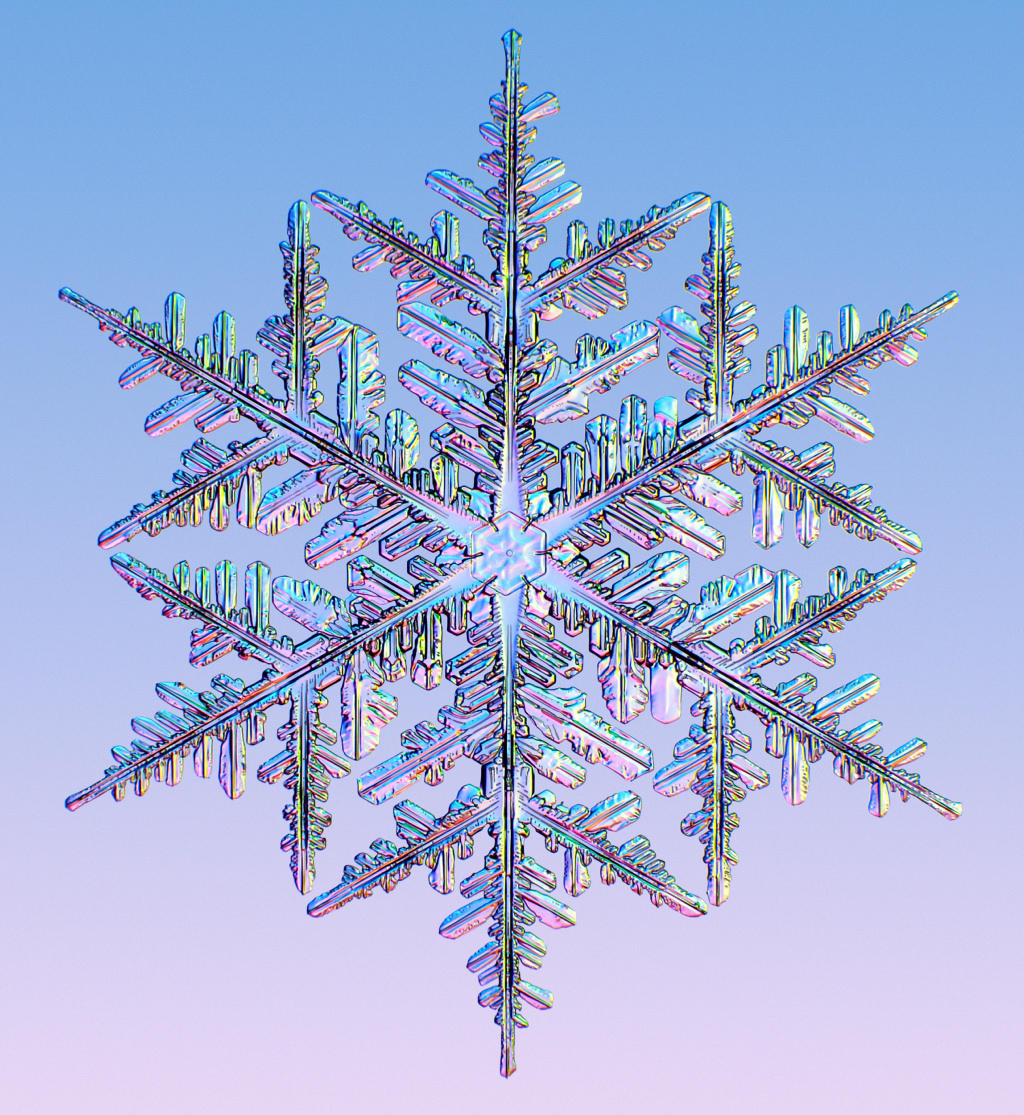
Snowfall forecast the next 2 days: Winter storm in the Plains/Midwest.
t Hour: 036
Image URL: http://mag.ncep.noaa.gov/data/nam/18/nam_namer_036_snodpth_chng.gif
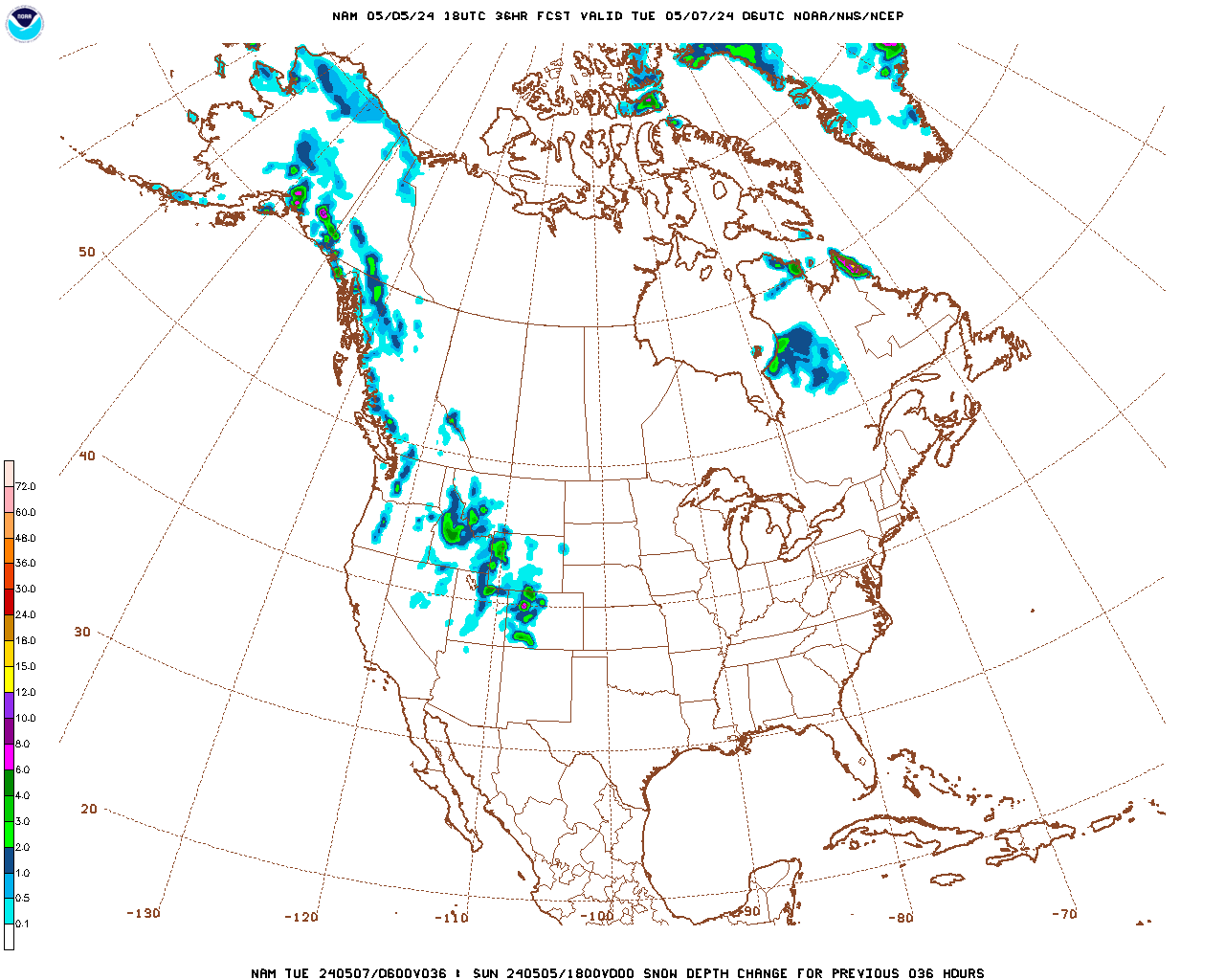
Chance for snow to accumulate greater than 4 inches below:
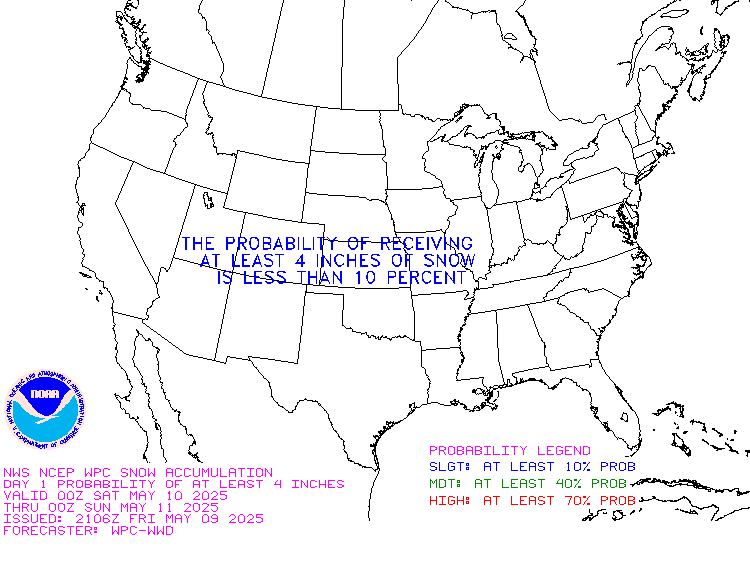
| Low Temperatures Tomorrow Morning |

High Temperatures today and tomorrow.
Warming up ahead of the next Winter blast. Record cold Northeast departs.



Highs for days 3-7:
The next blast of cold aimed at the NorthCentral US will be dropping southeast. Starts receding at the end of the week.
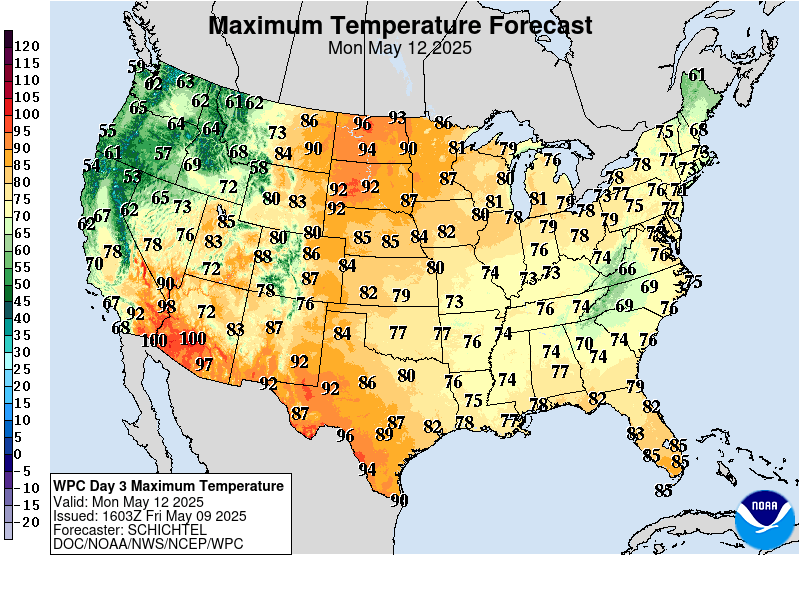
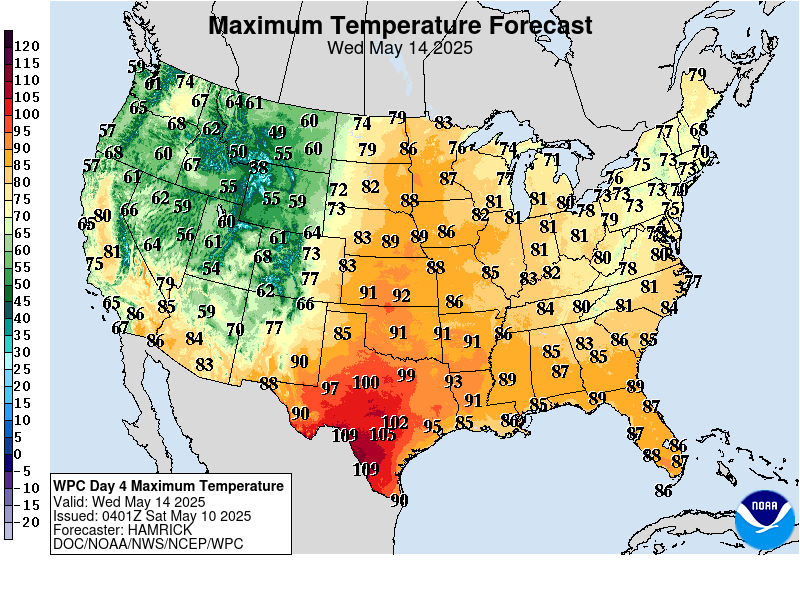
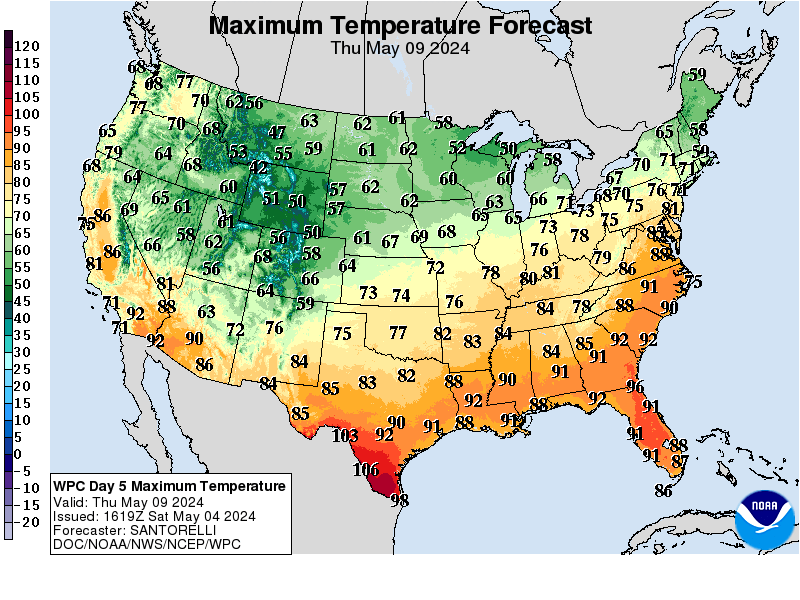
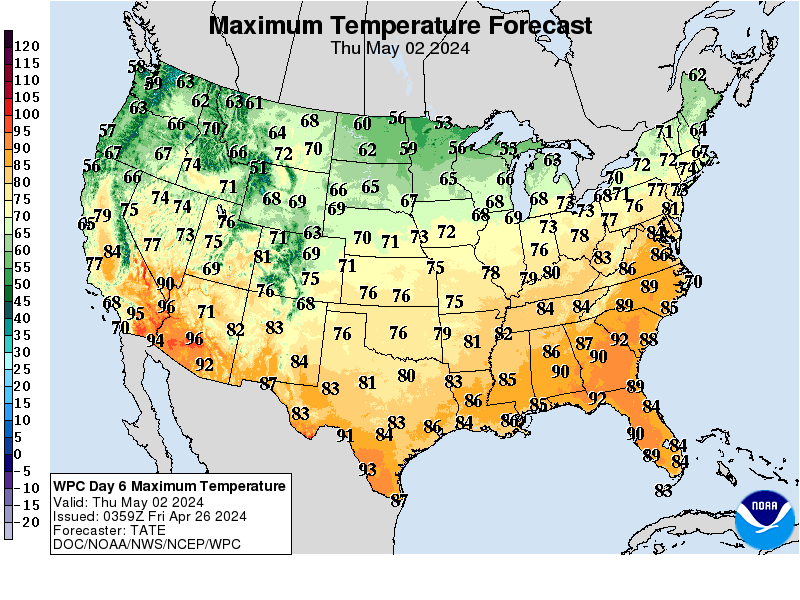
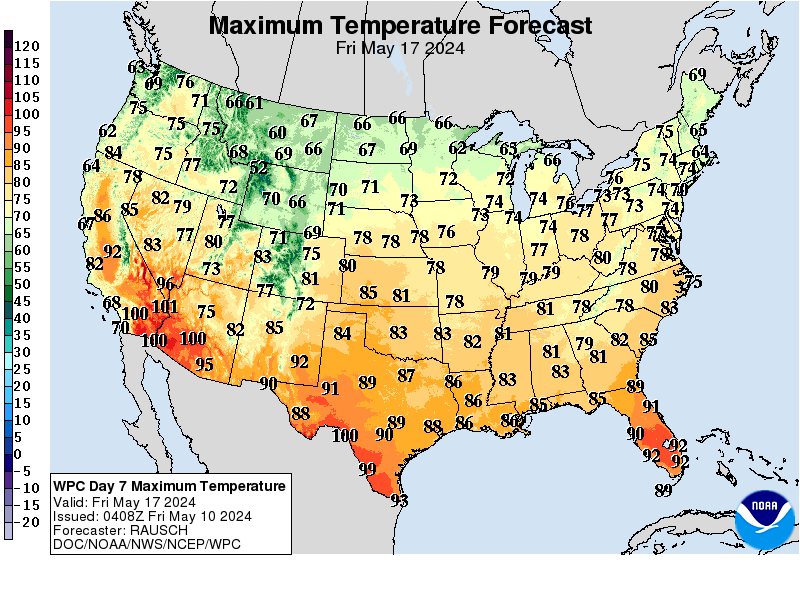
How do these days 3-7 temperatures compare to average at this time of year?
Cold blue anomalies are back in the Midsection to East Coast but not as extreme as earlier this month.
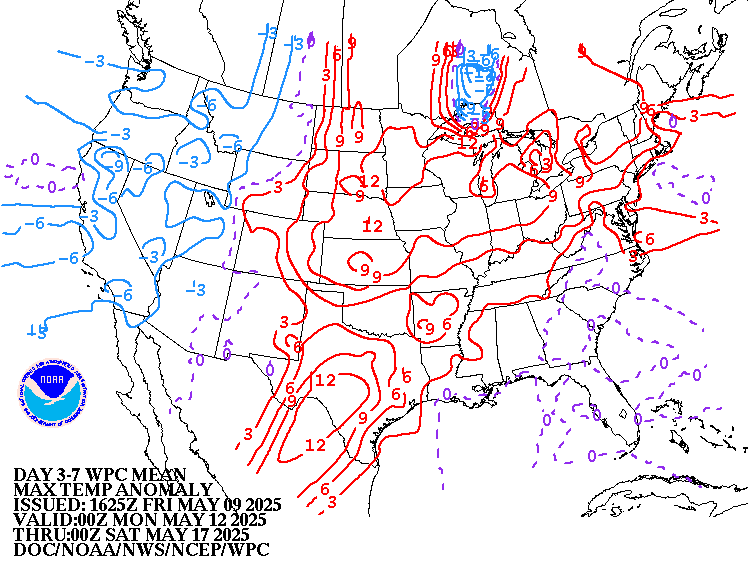
Low Temperature Departures:
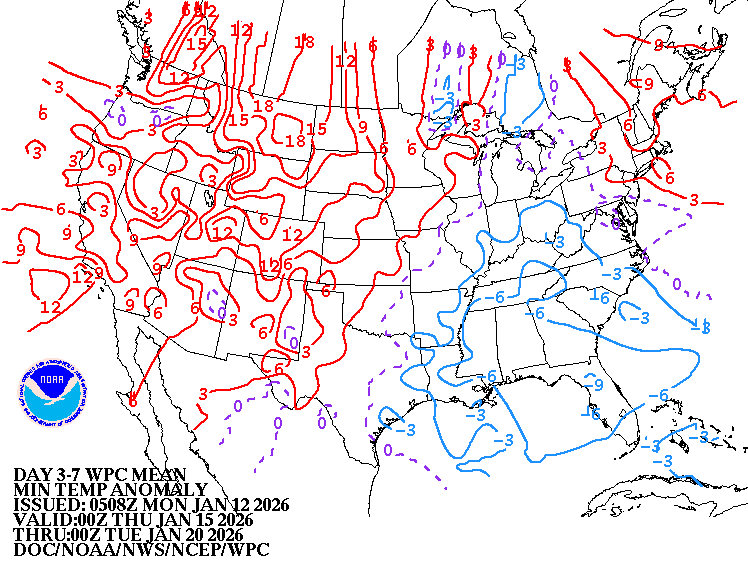
Surface features for the same 3-7 day period:
Big WINTER storm before this period with big blast of cold behind it, then Canadian High pressure for several days.....then the next storm towards the end of the week.
Pattern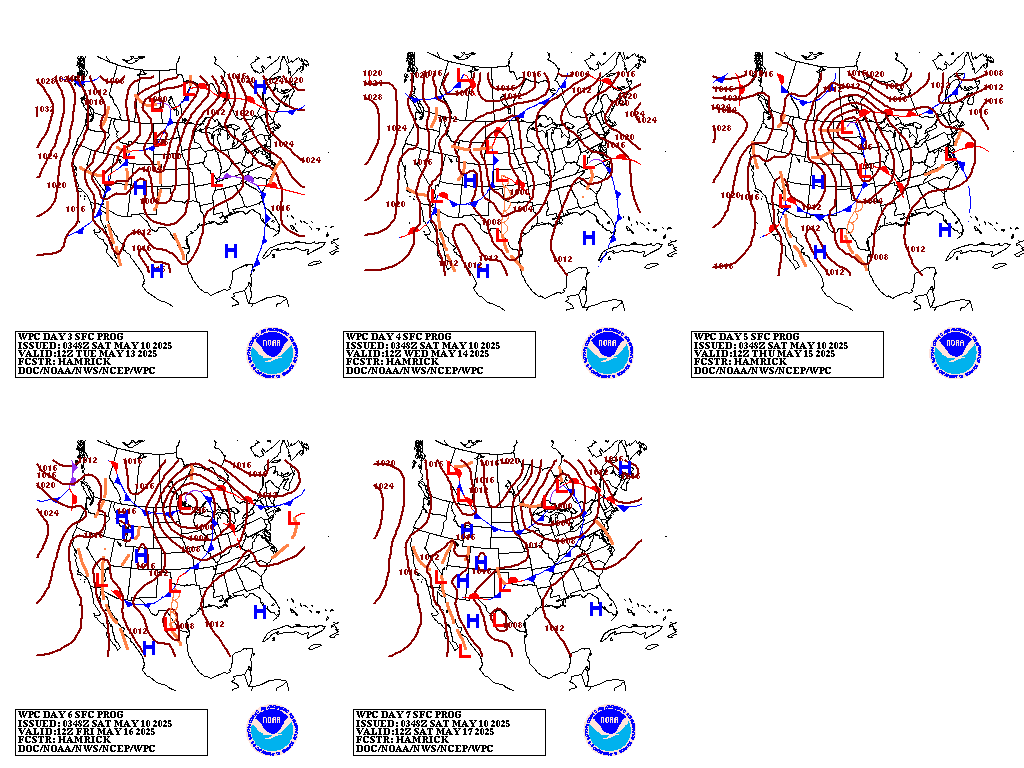
The latest liquid equivalent precip forecasts for the next week are below.
Some will be snow on the cold side of the Winter Storm Sunday/Monday.
Mostly quiet midweek.
New storm late week.
Day 1 below:
http://www.wpc.ncep.noaa.gov/qpf/fill_94qwbg.gif?1526306199054
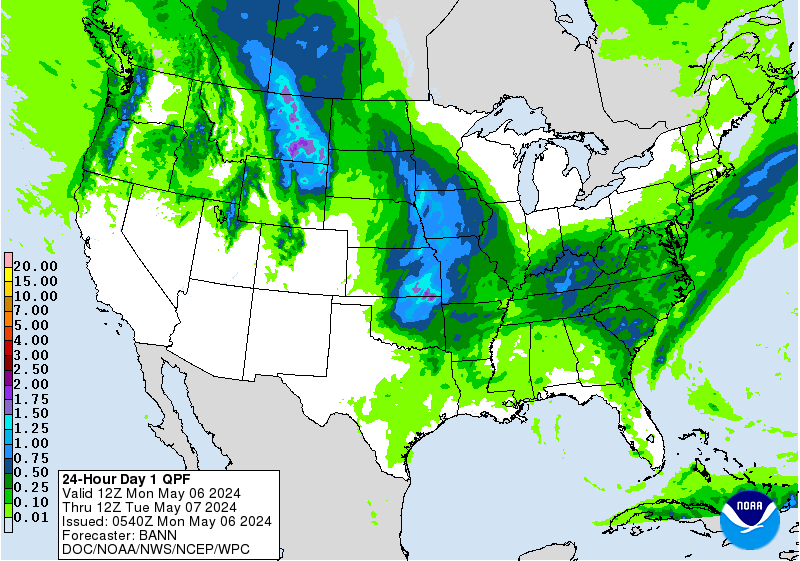
Day 2 below:
http://www.wpc.ncep.noaa.gov/qpf/fill_98qwbg.gif?1528293750112
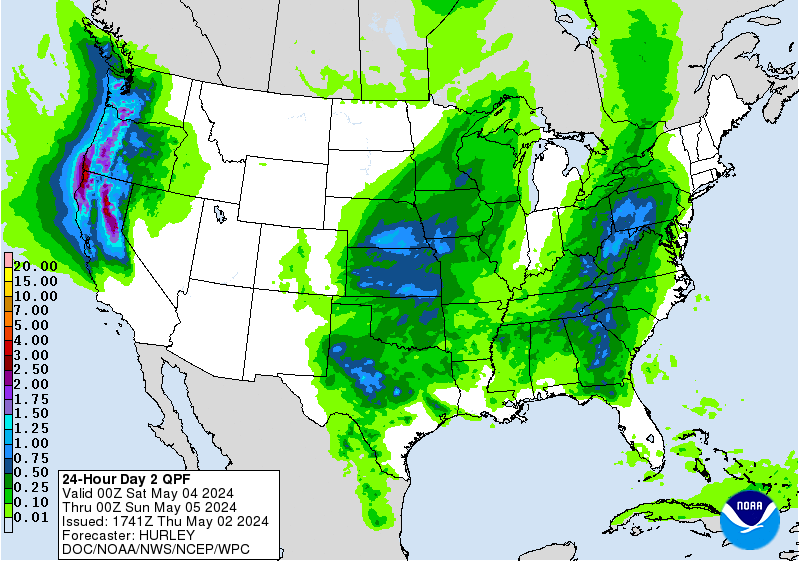
Day 3 below
http://www.wpc.ncep.noaa.gov/qpf/fill_99qwbg.gif?1528293842764
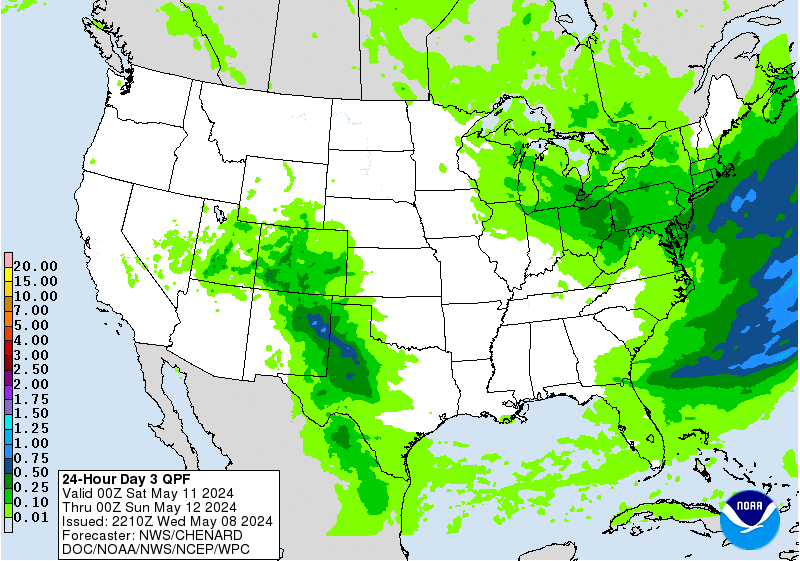
Days 4-5 below:
http://www.wpc.ncep.noaa.gov/qpf/95ep48iwbg_fill.gif?1526306162
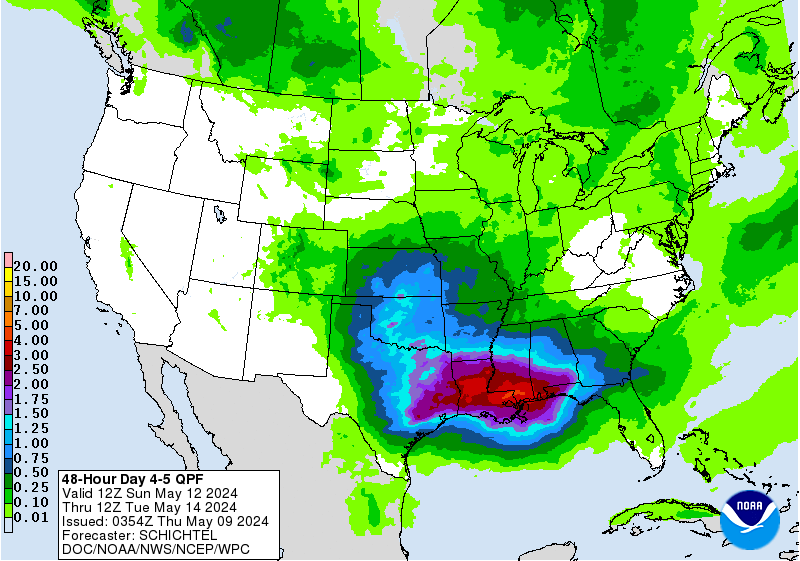
Days 6-7 below:
http://www.wpc.ncep.noaa.gov/qpf/97ep48iwbg_fill.gif?1526306162
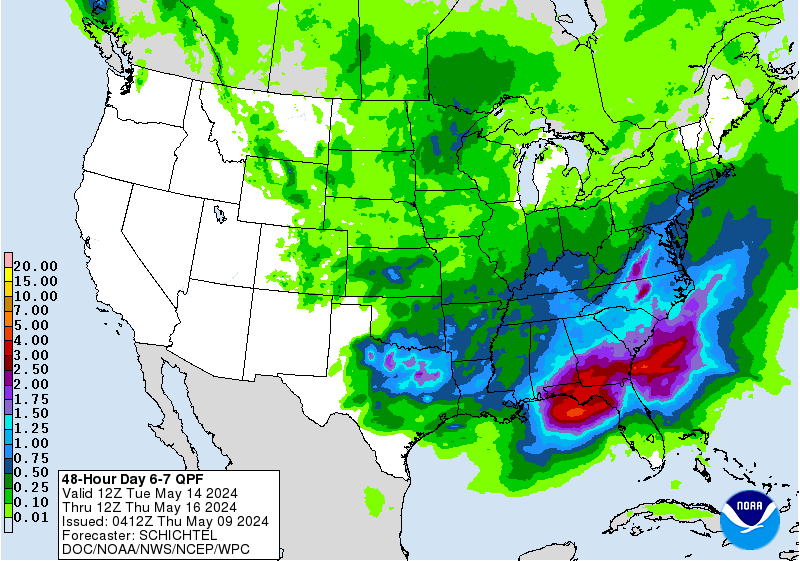
7 Day Total precipitation below:
http://www.wpc.ncep.noaa.govcdx /qpf/p168i.gif?1530796126
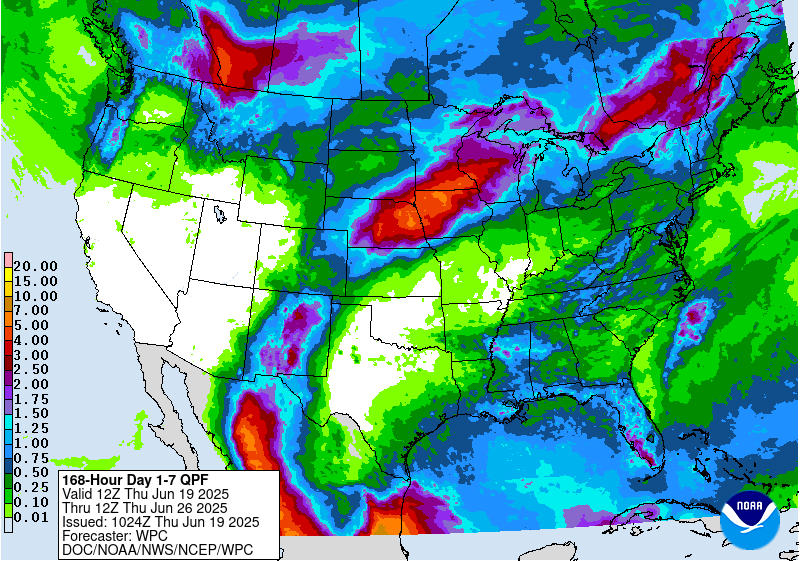
Current Dew Points

Latest radar loop
http://www.nws.noaa.gov/radar_tab.php

| Full resolution version loop (3400x1700 pixels - 2.2mb) |

Go to: Most Recent Image
Precipitation the past 24 hours
![]()
You can go to this link to see precipitation totals from recent time periods:
https://water.weather.gov/precip/
Go to precipitation, then scroll down to pick a time frame. Hit states to get the borders to see locations better. Under products, you can hit "observed" or "Percent of normal"
+++++++++++++++++++++++++++++++++++++++++++++++
Soil moisture anomaly:
Still wet on this particular metric in an enormous area.
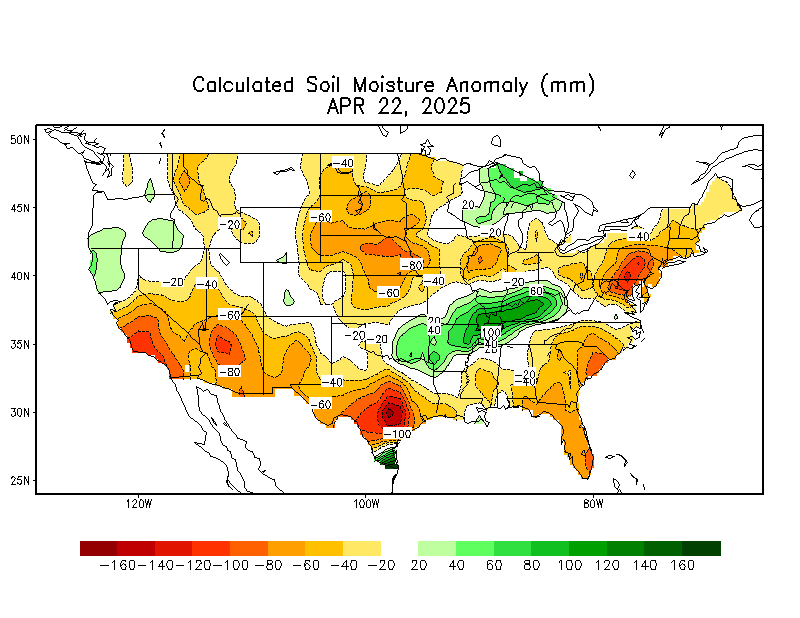
+++++++++++++++++++++++++++++++++++++
Precipitation compared to average for the last 7, 14, 30 and 60 days.
Usually not updated for previous day until late the next day.
https://www.atmos.illinois.edu/~snodgrss/Ag_Wx.html




The top map is the Canadian ensemble average, the maps below are the individual members that make up the average
End of week 2....................0Z ensembles from Saturday.
From Yesterday/Friday Big disparity still. Some are very cold with northern stream a major player. Along with that, is the risk that part of the polar vortex will take another excursion unusually far south. This would replenish the frigid weather reservoir to Canada, that gets depleted leading up to this period.
Some have mild/zonal flow that cuts off the cold.
Saturday:
Big change, actually huge change. The vast majority now are milder. Very few show the threat for the polar vortex to shift south
++++++++++++++++++++++++++++++++++++++++++++++++++++++++++++++
Each member is like the parent, Canadian model operational model.......with a slight tweek/variation in parameters. Since we know the equations to represent the physics of the atmosphere in the models are not perfect, its useful to vary some of the equations that are uncertain(can make a difference) to see if it effects the outcome and how.
The average of all these variations(ensembles) often yields a better tool for forecasting. It's always more consistent. The individual operational model, like each individual ensemble member can vary greatly from run to run.........and represent an extreme end of the spectrum at times. The ensemble average of all the members, because it averages the extremes.............from opposite ends of the spectrum.........changes much less from run to run.
360h GZ 500 forecast valid on Dec 09, 2018 00 UTC
0Z GFS Ensembles
Yesterday: A great deal of uncertainty at this time frame but still leaning strongly to cold for this model! Threat for polar vortex to start moving south again is elevated today.
Upper level trough somewhere.
Saturday: This model hasn't changed that much since Friday(but less threat for polar vortex shifting south). Looks like alot of widespread precip with an upper level trough and coldest temps west(possibly milder east of the Upper trough)

Latest, updated graph/forecast for AO and NAO here, including an explanation of how to interpret them.
Sunday's comment: For late week 2 here on Sunday. Huge disparity and change from recent solutions.
The AO was in uncharted low territory for awhile last week.........with extreme cold indicated but now is shown to just temporarily spike down(not quite as extreme) and bouncing back towards zero but still negative and decent cold indicator.
The NAO was also strongly negative last week and is showing the same tendency, a spike lower but bouncing back towards zero...........still remaining a bit negative at the end of week 2, suggesting cold.
The day to day changes are big enough to generate low confidence.
Monday: 2nd day in a row that shows the same thing. Negative AO and NAO are recovering at the end of the period.........reducing the threat of extreme cold for early December.
Tuesday: The trend towards a reduction in the magnitude of the negative AO and NAO continues. It morphs towards zero at the end of the period, lessening the risks for extreme cold in early December.
Wednesday: AO and NAO diving into solid negatives then rebounding. AO STAYS negative, more so then Tuesday. NAO keeps rebounding to near zero at the end of 2 weeks. Huge spread and uncertainty.
Thursday: AO and NAO show the dive to negative being shorter lived than previous bouncing back closer to, if not all the way back to zero at the end of 2 weeks. This reduces cold risks in December.
Friday: Huge change late in the period. Negative AO and NAO, after bouncing back, on all members crash to extremely low values and the end of 2 weeks...............on a slight majority, while on a minority, keep going higher and even poke above zero.The spread/disparity is "off the charts" especially with the AO but the average is MUCH colder than yesterday/Thursday.
Saturday: Not nearly as cold as Friday. AO and NAO still negative but closer to 0 as week 2 goes on(especially the NAO).
NAO close to 0 vs strongly negative reduces cold risks in the East.
https://www.marketforum.com/forum/topic/15793/
National Weather Service 6-10 day, 8-14 day outlooks.
Updated early this afternoon.
Widespread precip, milder east.
Temperature Probability | |
Precipitation Probability | |
| the 8-14 day outlooks ArchivesAnalogsLines-Only FormatGIS Data | |
Temperature Probability | |
 | |
Week 3-4 look.....mid December.
Warmer and dry???
| Week 3-4 Outlooks | ||
| Valid: 08 Dec 2018 to 21 Dec 2018 Updated: 23 Nov 2018 | ||
| Please provide comments using the online survey. | ||
Temperature Probability | Precipitation Probability (Experimental)  | |
Previous discussion:
By WxFollower - Nov. 20, 2018, 4:34 p.m.
Mike,
Have you noticed that the average anomaly for US highs has been much colder than that for the lows, especially in recent weeks? Is that related to global warming and the very warm oceans? I know the SW Atlantic just off the SE US remains quite warm anomalywise though it is starting to cool some.
++++++++++++++++++++++++++++++++++++
By metmike - Nov. 20, 2018, 7:44 p.m.
Yes Larry, great observation!
Actually this has been going on for 2 decades.
It's been causing highs to be lower and lows to be higher. This has done several things.
It's decreased the diurnal temperature spread.
It's causing record warm minimums to exceed record warm maximums.
Related to that, its reducing record warm maximums vs where they would be and reducing record cold minimums.
It's been warming the coldest places on the planet the most, especially during the coldest times of year.
It's reduced extreme highs in the Summer vs where they would be without this going on.
I think the increase in H2O in the air can be part of it but the increase in CO2, causing the "greenhouse" effect could explain most of it by itself. This effect would be greatest in the coldest places and at night(Polar latitudes have night time conditions all Winter long), when long wave radiation dominates the heating signal......CO2 plays a key role with the long wave radiation...........more of it, means more heat stays in the atmosphere.
So higher minimums.
During the day solar, short wave radiation dominates the heating signal, so greenhouse gas warming from more weaker, long wave radiation is not as important. So not as many higher maximums because the intensity of the sun(TSI) has not changed much.
+++++++++++++++++++++++++++
By metmike - Nov. 20, 2018, 7:51 p.m.
This was a good article on it:
http://www.climatecentral.org/blogs/record-warm-nighttime-temperatures-a-closer-look
But looking at these four types of records, it appears that nights have warmed even more: the average month recorded 10 percent more record high minimum temperatures than record high maximums. The record low temperatures tell an even more compelling story: it was much more likely for the daytime temperature to be colder than average than it was for the nighttime ones. There were only 1,235 record low minimum temperatures set per month, while there were 1,697 record low maximum temperatures set per month. By this measure, a record cold day was 40 percent more likely than a record cold night.
Interestingly, when I looked at different months of the year, I found that the nighttime warming was even greater during the summer. During June, July and August, record high minimum temperatures outnumbered record low minimum temperatures by about three to one.
More cloudiness could also explain part of it, as clouds trap heat from escaping at night and block heat from getting in during the day.
+++++++++++++++++++++++++++
By metmike - Nov. 21, 2018, 9:50 p.m.
See comments in the natural gas thread about the polar vortex and this being the coldest Thanksgiving in the last century in the East/Northeast:
https://www.marketforum.com/forum/topic/17783/
Why does anyone believe anything the GFS says past about day 7 and especially past day 10? (not just talking about this latest very cold 18Z run). Look at how cold it now is vs the SE warmth that was shown just a couple of days ago on most runs. It clearly has had the warmest bias of any of the major models. So, those warm runs turning colder is not a surprise. But it tends to vary so much from one run to the next past about day 10.
Fortunately, the NG market (among others) has learned to not react as much as it used to (years back) post day 10 of the GFS since the market realized that it should be taken with a grain.
For that matter, any details about storms, etc., past about day 7 on most runs of operational models should be taken with a grain. But the GFS has been extra horrible recently. That's where the ensemble means become more valuable as a forecasting source. Week #2 in general is much less unreliable on the ensembles vs the operationals.
Great points Larry.
Here is the latest 18z GFS operational model run for day 10, then day 15.........Siberian Express!!!
gfs_namer_240_200_wnd_ht | gfs_namer_240_500_vort_ht |
gfs_namer_240_1000_500_thick | gfs_namer_240_850_temp_ht |
Day 15 below:
gfs_namer_360_200_wnd_ht | gfs_namer_360_500_vort_ht |
gfs_namer_360_1000_500_thick | gfs_namer_360_850_temp_ht |
Here are the same time frames for the GFS ensemble average-18z (a bunch of GFS solutions with slight variations in different parameters to yield different solutions-some extreme some not but the average of them stays consistent/doesn't change as much from run to run)
The maps below are 500 mb heights........around halfway up in the atmosphere. The upper level winds tend to flow in the direction of the lines, almost parallel to them. Think of the lines as being channels for air flow, like the banks for a river of air.
The day 10 map, which has gotten quite a bit colder in recent runs, actually doesn't look that much different than the operational model for the same time frame. At day 15(360 hours) one of the biggest reasons that it loses the extreme nature of the flow/pattern is because some of the ensembles have the opposite pattern, a much milder pattern, with Pacific flow undercutting the strong northern stream that was in control at day 10. When averaged in with the very cold members, we get something in between.
| Next >> |
Forecast Hour: 240
Image URL: http://mag.ncep.noaa.gov/data/gefs-mean-sprd/18/gefs-mean-sprd_namer_240_500_vort_ht.gif
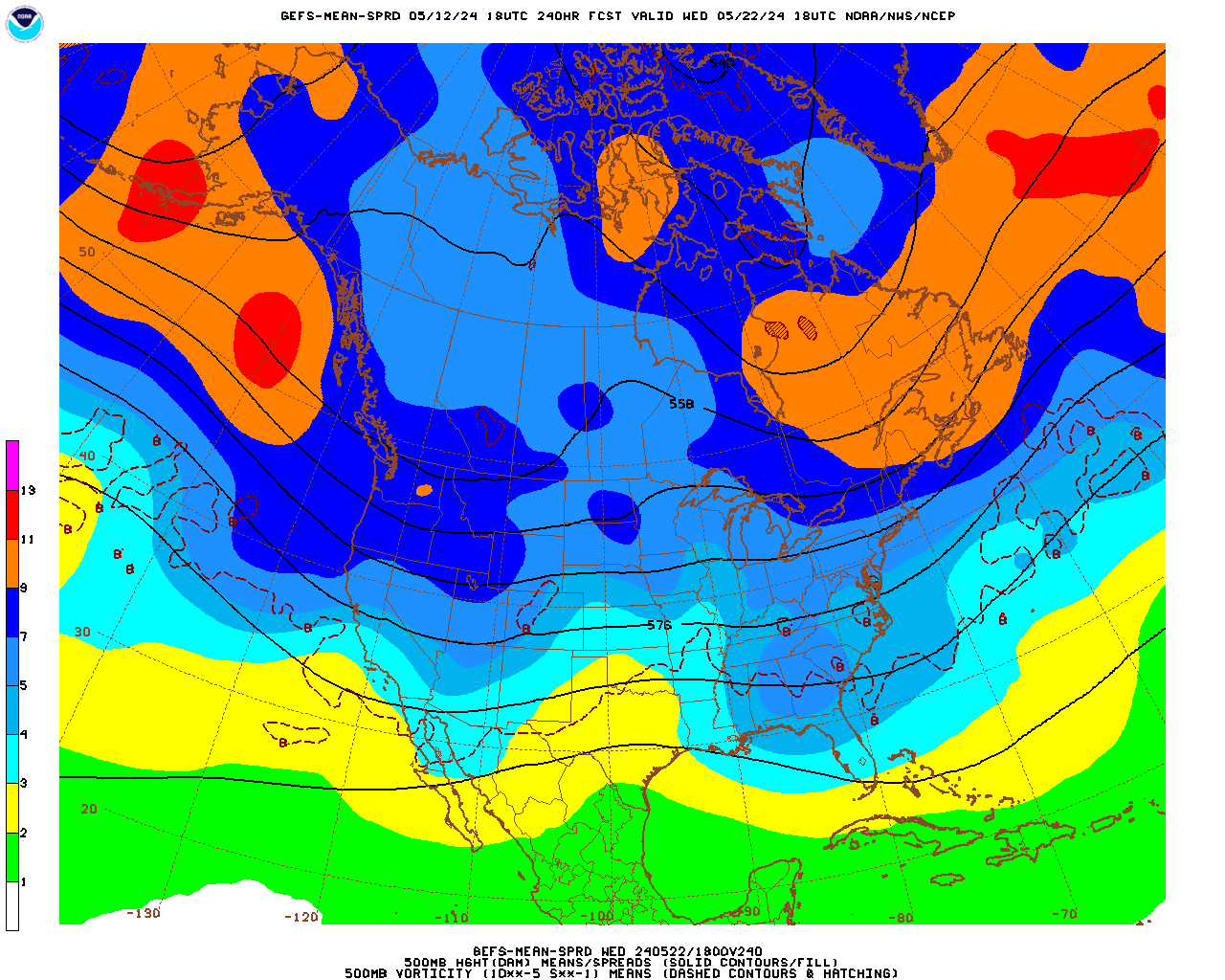
Day 15 below:
| Next >> |
Forecast Hour: 360
Image URL: http://mag.ncep.noaa.gov/data/gefs-mean-sprd/18/gefs-mean-sprd_namer_360_500_vort_ht.gif
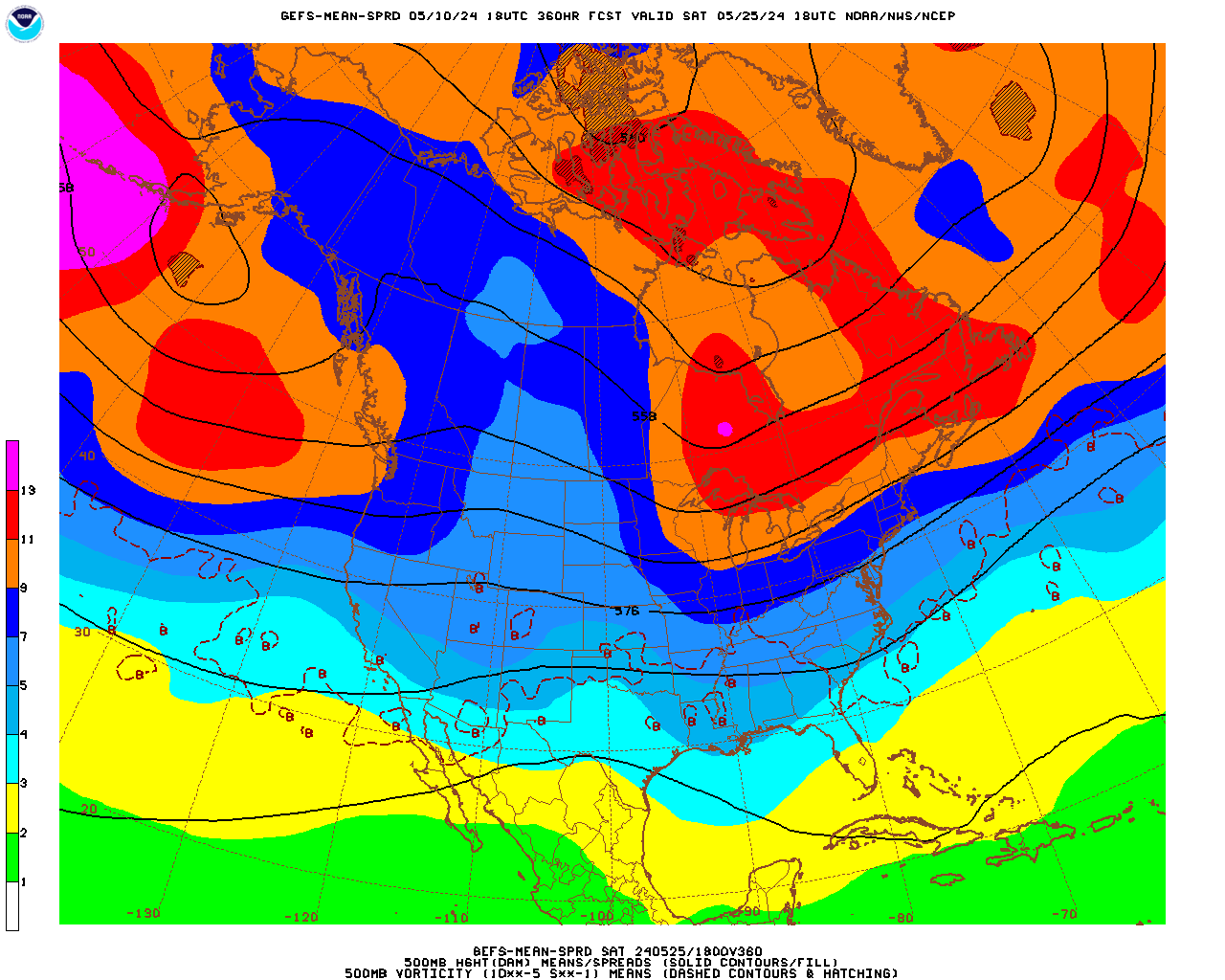
Looking closer at the 18z ensemble, for an ensemble run, its quite a bit colder during week 2 than the previous runs, especially late in that period.
Here are the 850 mb temperatures(around 1 mile up in the atmosphere).
Last nights 0z ensemble average had an 850 mb temp of -3 deg C in Chicago. For the same time frame on this latest run, the 850 mb temp is -10 deg. C.
That's alot of an ensemble mean change in 18 hours. Considering that the models have underestimated cold for the past month, this is something to pay close attention too.
What makes this especially interesting is that the European and Canadian models are almost completely opposite.........showing very mild temperatures spreading across the country.
Forecast Hour: 360
Image URL: http://mag.ncep.noaa.gov/data/gefs-mean-sprd/18/gefs-mean-sprd_namer_360_850_temp.gif
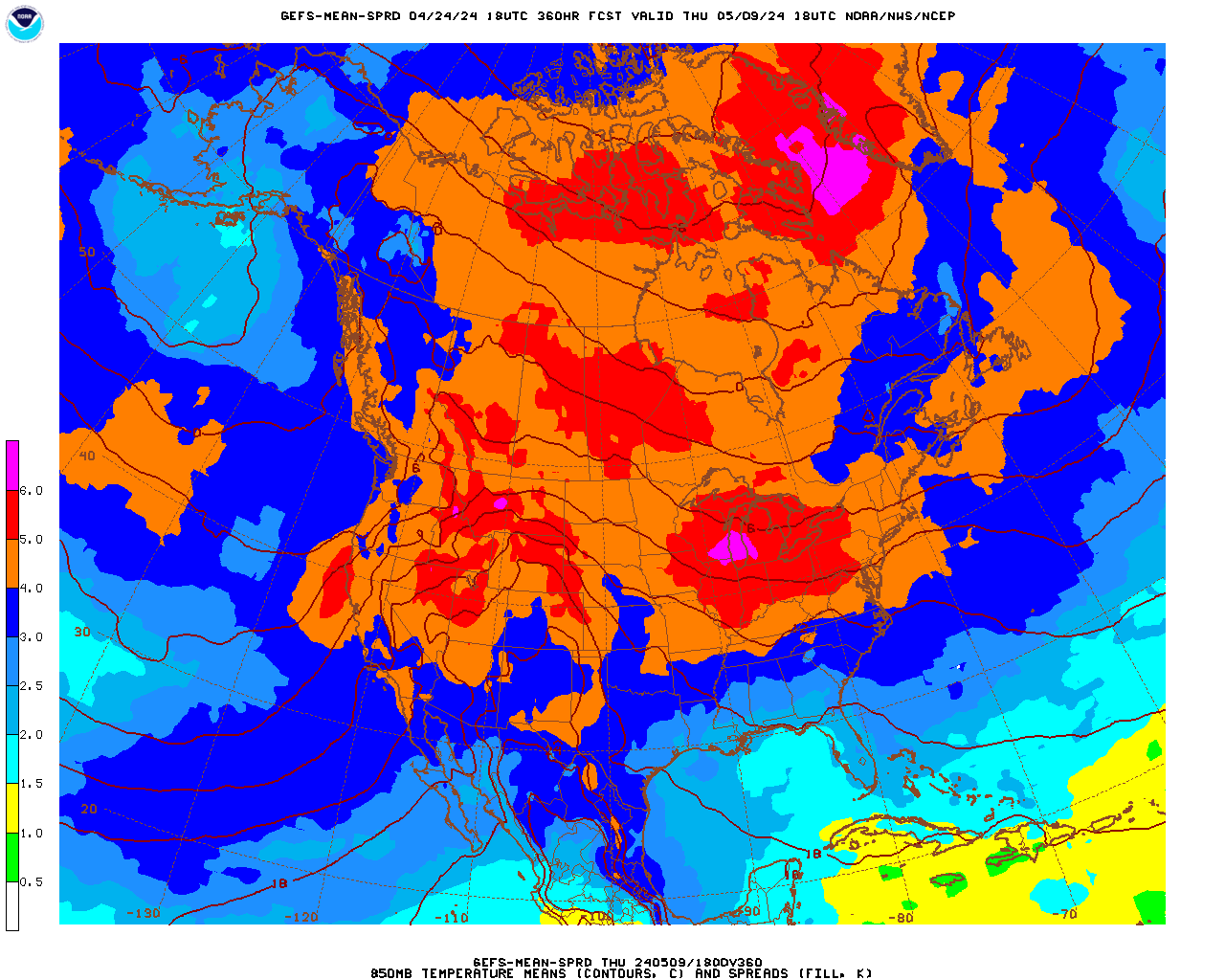
This was the last 12z run for the Canadian ensembles with the average at the top.
Much different than the GFS Ensembles. One should also note the huge spread in the AO at 14 days that reflects this huge difference. Some members are strongly negative with the risk of frigid weather, some members are near zero, low risk of frigid weather.
Lots of conflicting signals. The recent pattern has favored very strong cold........but the Pacific is supposed to be morphing into an El Nino which favor warmth.
The Madden Julian oscillation, I think is moving towards increasing odds of cold. This and models not being cold enough recently has me leaning towards the GFS right now(though the European model ensembles has a slightly better track record)
Actually, I just checked how each of the models have been doing recently and the GFS ensembles have been clearly outperforming the other models in the extended range. It's #1 in the 6-10 day period and is mopping the floor with the other models in the 11-15 day period(which have been doing horrible-too warm). This has me leaning strongly towards the colder solution.
360h GZ 500 forecast valid on Dec 09, 2018 12 UTC
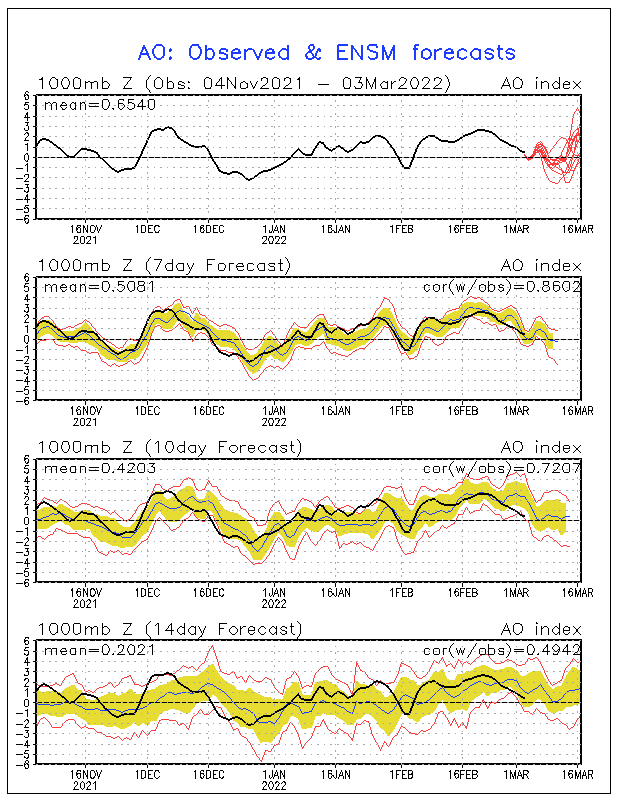
Mike,
Per history, with El Niño likely not getting any stronger than low end moderate, that is actually often a cold rather than warm signal for at least much of the eastern half of the US. I wasn’t sure if you realized this. Many of the coldest winters in the E US were actually weak to low end moderate El Niño’s: 1884-5, 1885-6, 1904-5. 1911-12, 1939-40, 1963-4. 1968-9, 1969-70, 1976-7, and 1977-8.
Then again, we still have -AAM, which is most often associated with La Nina and usually not as cold for much of the E US. Having the -AAM in combo with El Nino is quite unusual from what I learned from Radiant though I wonder if it will hang on through winter.
Does anyone have a link to an historical monthly AAM table?